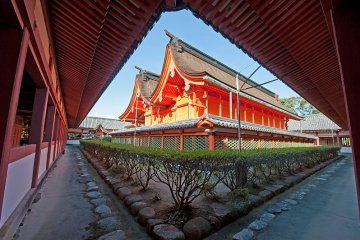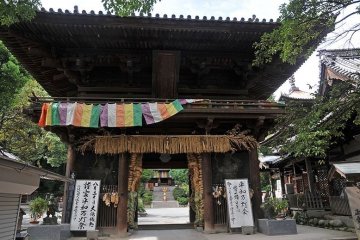
Dogo Onsen Matsuri 2026
Bronwyn O'NeillSetiap bulan Maret, Dogo Onsen dihiasi dengan lentera dan ornamen-ornamen bergaris merah untuk merayakan sejarah budayanya dan menyediakan tempat bagi komunitas lokal untuk berkumpul.

Dogo Onsen, in central Matsuyama, is one of Japan's oldest hot springs with the main honkan one of the most famous locations at its very center. This wooden public bathhouse dates back to 1894 (Meiji Period) and is said to be one of the inspirations behind film director Hayao Miyazaki's acclaimed Spirited Away anime.
The iconic, 130-year-old main bathhouse at Dogo Onsen reopened fully in July 2024 after a 5.5 year hiatus from renovation and repair work.

Setiap bulan Maret, Dogo Onsen dihiasi dengan lentera dan ornamen-ornamen bergaris merah untuk merayakan sejarah budayanya dan menyediakan tempat bagi komunitas lokal untuk berkumpul.

Spa Ryokan Dougoya menawarkan pengalaman bergaya ryokan dalam bangunan 1930an di Dogo untuk budget traveler.

Matsuyama adalah ibukota perfektur Ehime dan merupakan kota terbesar di Shikoku. Memiliki arti nama “gunung pinus”. Matsuyama merupakan kota sibuk yang mempertahankan semangat gairah hidup meskipun dibayangi resesi panjang seperti kota-kota lain di Jepang. Matsuyama merasakan manfaat keberhasilan pimpinan dua walikota muda yang keduanya menaruh perhatian besar pada pariwisata. Kota memiliki bar dan restoran, menawarkan pilihan makanan dari seluruh dunia, sebagai tambahan makanan khas lokal seperti babi hutan dan ikan air tawar. Matsuyama merupakan rumah dari Dogo Onsen, rumah mandi mata air panas tertua di Jepang. Dogo Onsen masuk dalam artikel Michelin Green Guide, dan menjadi inspirasi dari animasi besar yang sangat populer Spirited Away. Pemandangan favorit lain adalah Kastil Matsuyama yang terletak di atas sebuah bukit tepat di tengah kota dan memiliki arti penting. Kuil ke delapan dari delapan puluh delapan kuil ziarah Shikoku berlokasi di Matsuyama, dan peziarah yang berjalan menuju kuil menjadi pemandangan biasa. Kuil Buddha yang terkenal dan indah di Matsuyama termasuk Ishite-ji, Taisan-ji, dan Jodo-ji, semuanya berasal dari abad ke delapan. Ishite-ji merupakan tempat yang aneh, termasuk dari serangkaian terowongan yang menakjubkan dengan bukit sebagai latar belakangnya. Kuil terkenal dari kota ini termasuk Isaniwa Jinja dan Tsubaki Jinja. Pada abad pertengahan, Matsuyama merupakan bagian dari Iyo-Matsuyama Domain, tanah perkebunan sebagai bagian dari pelayanan masa feodal provinsi Iyo termasuk didalamnya kota kastil, dengan desa Dogo Onsen hingga ke arah timur dan pelabuhan di arah barat dari Mitsuhama yang menghubungkan wilayah daratan Jepang dan Kyushu. Penyair haiku Masaoka Shiki tinggal di Matsuyama. Rumah beliau, sekarang disebut sebagai Shiki-do, dan sebuah museum, Shiki Memorial Museum, menjadi atraksi menarik, dan menjadi alasan utama kota yang memiliki peran dalam pergerakan haiku internasional. Novel Botchan yang dikarang oleh Natsume Soseki juga berlatar belakang Matsuyama. Terlepas dari kenyataan bahwa Soseki mengolok-olok dialeknya, apapun yang berada di kota ini disebut dengan Botchan ini dan Botchan itu. Matsuyama juga muncul dalam beberapa karya Shiba Ryotaro, terutama pada novel tahun 1969, Saka no Ue no Kumo (Awan di Atas Bukit). Hal inilah yang menjadi fokus utama dari penciptaan merek di bawah kepemimpinan walikota sebelumnya, yang menghasilkan drama panjang NHK yang diadaptasi dari novel tersebut, dan museum yang didisain oleh arsitek ternama Tadao Ando. Situs bersejarah lainnya yang layak untuk dilihat adalah Museum Itami Juzo yang didedikasikan kepada pengarah film terkenal. Secara fisik, Matsuyama merupakan kota yang cukup terpadu. Pusat kota dilayani oleh sistem trem dengan trem indah dari tahun 50-an dan 60-an, begitu juga dengan replika kereta uap yang indah, Botchan Ressha. Kota dikelilingi dengan pegunungan dan penggabungan sejumlah bukit, membuatnya terlihat hijau, dan memiliki perasaan berada di pedesaan. Tidak jauh dari jangkauan kota terdapat beberapa pantai berpasir menghadap air laut dalam Seto yang tembus cahaya. Kota juga memiliki beberapa gedung tua yang telah ada sejak periode Meiji bahkan periode sebelumnya. Terdapat beberapa gedung bergaya yang dibuat oleh arsitek Shiciro Giko, termasuk Vila Bansuiso yang penuh warna. Bandara Matsuyama memiliki penerbangan reguler menuju Tokyo, Osaka, dan kota-kota besar di Jepang lainnya, termasuk juga beberapa tujuan pilihan Asia termasuk Shanghai dan Seoul. Terdapat feri reguler menuju Hiroshima, termasuk feri ekspres yang hanya membutuhkan waktu satu jam. Feri malam menuju Kobe, Kokura, dan Kitakyushu.

Restoran Nikitatsu-An di Dogo menghidangkan makanan Jepang dengan harga yang pantas untuk menemani sake dan bir berkualitas tinggi yang diproduksi dari tempat pembuatan di sebelahnya.

Menyediakan ramen tonkotsu yang ditaburi irisan daging menggunung.

Ramen mewah di Matsuyama dengan saus kedelai dan suasana yang menyenangkan.

Thought to be at least 1,000 years old, Isaniwa is one of Japan’s three shrines dedicated to the deity Hachiman. After climbing a long stretch of stone stairs, passing a double-story gate, a magnificent bright-red structure emerges. The architectural details are especially grand with the building’s swooping tile roofs, gold-leaf columns and ornate, cloudlike beam engravings. In addition to the spectacular architecture, there are displayed paintings of warriors and warfare (as Hachiman is the guardian of warriors and protector of Japan) and even numerous documents on Japanese mathematics. A hall of treasures features swords and armor for samurai history buffs. Other relics include animal paintings and calligraphy. Supposedly, Isaniwa Shrine originally marked the location where Emperor Chuai and Empress Jingu, who reigned in the third century AD, bathed at one of Japan’s oldest bathhouses, Dogo Onsen, now just a few hundred meters away. The shrine was moved to by the Kono samurai clan in the fourteenth century to the current location where, after conquering the stairs, you can enjoy breathtaking views of Matsuyama city. It was rebuilt in the 17th century by the Matsudaira clan; the current buildings with their great vermilion surface date from 1667. The original imperial bathers are enshrined there. Despite its age, the shrine is still buzzing with worshippers and even couples celebrating or taking pictures for their wedding. Although visitors note that the stairs are a little treacherous, the views and tranquil atmosphere only add to the experience of walking around the colonnade and absorbing a rich and long history—and if you’re lucky, observing a modern-day ceremony. If the trip does tire you out, you can always relax at Dogo Onsen at the foot of the compound.

At Matsuyama’s most famous temple, a sight almost as guaranteed as the temple buildings themselves is the cadre of pilgrims in white traveling the Shikoku Pilgrimage, a circular 88-site, 1200-kilometer circuit. Whether you’re at Ishiteji for religious, ascetic or sightseeing reasons, the compound is sprawling and quite unusual. On both sides of Niomon Gate (a National Treasure) are two monumental straw sandals, promising relief for those suffering with painful leg conditions. As you reach the main area, you’ll be greeted by even more curiosities. Stroll through the main hall, itself lined with vibrant panel paintings, enter a cave and you reach yet another temple. This inner structure resembles a large golden bead and contains a famously eclectic collection of sculptures, carvings and paintings. Particularly arresting are the images of the skeletal historic Buddha in the period before his enlightenment. Accompanying these are countless Kannon figures, dwarves, demons and deities. Kobo Daishi, a famous Buddhist monk who supposedly originated the Shikoku Pilgrimage, is immortalized in a towering statue on a nearby forested hill. On top of its treasure-packed halls, a three-story pagoda occupies the main grounds. Ishiteji, which literally means “stone hand temple,” has an origin story as unique as its contents. A man had wronged Kobo Daishi and, wanting to atone, established the path of the Shikoku Pilgrimage in search of the monk. When they finally met, Kobo forgave him and gave him an inscribed stone with which he was buried. Then a boy was born with a stone clenched in his hand; this boy came to build Ishiteji. The legendary stone is still in a small museum on the compound, surrounded by no shortage of similarly precious relics, treasured buildings and, supposedly, people’s souls. If Ishiteji Temple proves to be sensory overload or a tiring trek, historic Dogo Onsen is a few minutes away.

Most might not expect to find a French-style villa below Matsuyama Castle, but this elegant construction offers a respite from the bustling town center of Ehime. Bansuiso, largely hidden by trees and modern buildings, was originally the second Residence of Count Hisamatsu Sadakoto, a descendant of the Matsuyama samurai clan and former lord of the neighboring castle. After living in France and returning with his love of Neo-Renaissance architecture, he commissioned the construction of the villa. Completed in 1922, it was the scene of numerous elite parties and social gatherings, and even welcomed members of the imperial family as guests, including Showa Emperor Hirohito. Bansuiso serves as both a place of art and culture and a sight. The first floor and the basement are freely accessible and for ¥ 300 visitors can climb a wooden staircase to take advantage of more photo opportunities. Although the villa hosts solo exhibitions, it also has its own murals and portraits, including the portrait of the first owner.